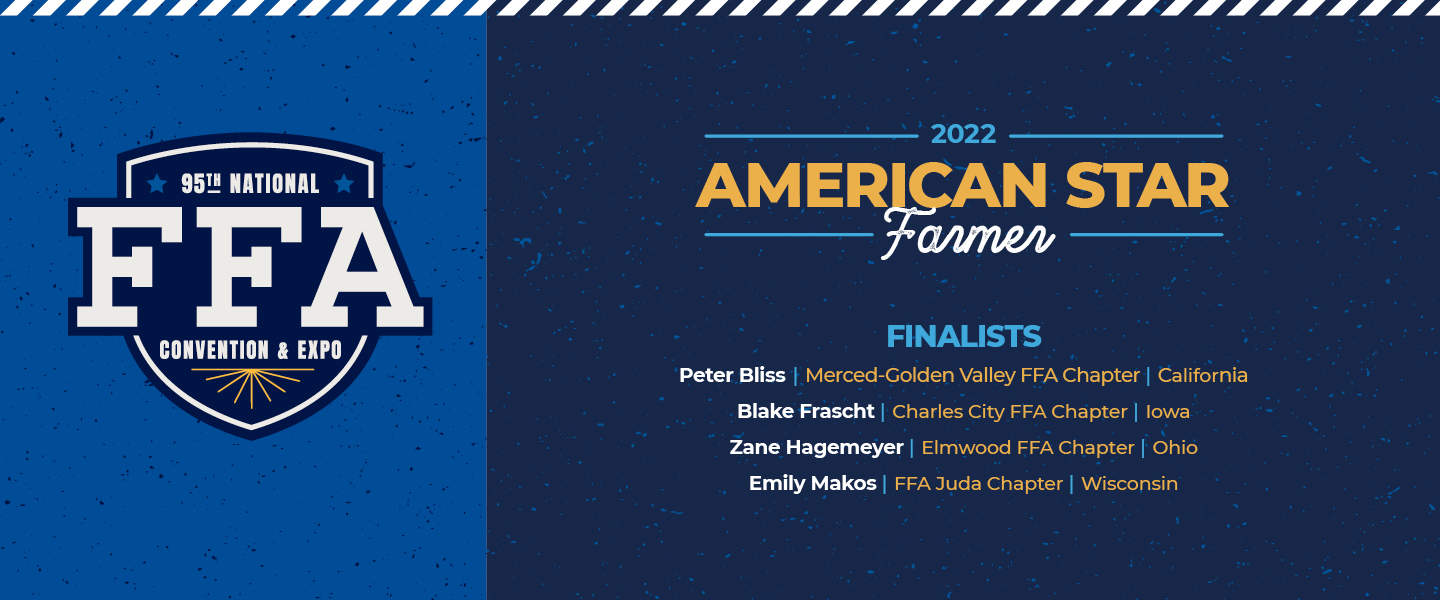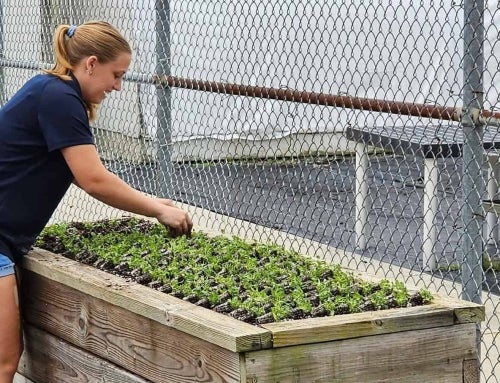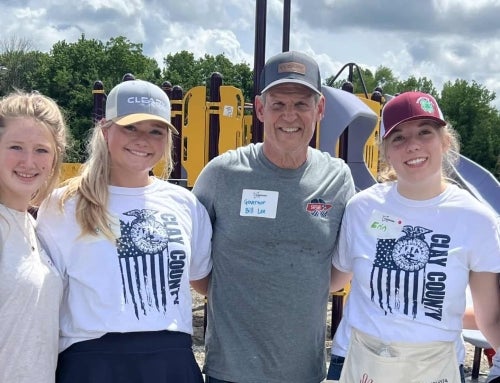Each year at the National FFA Convention & Expo, four FFA members are honored with American Star Awards for outstanding accomplishments in FFA and agricultural education.
The American Star Awards, including American Star Farmer, American Star in Agribusiness, American Star in Agricultural Placement and American Star in Agriscience, are presented to FFA members who demonstrate outstanding agricultural skills and competencies through completion of supervised agricultural experience (SAE). A required activity in FFA, an SAE allows students to learn by doing, by owning or operating an agricultural business, working or serving an internship at an agriculture-based business, or conducting an agriculture-based scientific experiment and reporting results.
Other requirements to achieve the award include demonstrating top management skills; completing key agricultural education, scholastic and leadership requirements; and earning an American FFA Degree, the organization’s highest level of student accomplishment.
The American Star Farmer is awarded to the FFA member that demonstrates the top production agriculture SAE in the nation. Here are the 2022 winner and finalists for American Star Farmer:
WINNER: Peter Bliss, California
Farming is a family business for many, but for folks like Peter Bliss, it’s more than that — it’s a lifelong dream.
“I definitely am going to farm for the rest of my life,” Bliss said. “I was about six years old when I told myself I was going to farm, and that’s what I’ve been doing ever since.”
Bliss is a member of Merced-Golden Valley FFA in central California, and his supervised agricultural experience (SAE) project sees him farming cotton, almonds and wheat. He started with only 30 acres inherited from his grandfather, but his operation has since grown to exactly 417 acres.
“I’m a fifth-generation Bliss farmer,” he said. “We started in the 1880s … and I want to continue this tradition.”
Specifically, Peter has 212 acres for cotton, 105 acres for almonds and 100 acres for wheat. Most of his land is rented, he said, but he wants to own it all someday.
In the future, Bliss plans to expand his operation by planting new kinds of crops in addition to his usual big three. In fact, he said he’s already planted corn silage just recently.
“I plan to diversify a little bit more, get into other crops like corn and hay,” Bliss said. “I’d like to grow in size. That’d be really nice.”
Although his SAE is successful now, Peter said he had a rocky start with FFA. He wasn’t satisfied with the program at his first high school, so he moved to a different high school between his sophomore and junior years.
“I just wasn’t comfortable inside the ag program,” Bliss said. “I’d say I switched [schools] solely for the purpose of FFA, and then my opportunities took off.”
He didn’t build his SAE alone, though. He said his biggest supporters are his family, his FFA advisor Cody Jacobsen, and a family friend named Scott Apupel — or, as Bliss likes to call him, “Dad Number Two.”
For FFA members starting their own SAE, his best advice is to give it your all.
“You’ve got to put in 100 percent effort,” Bliss said. “You can’t come in competing in an SAE contest … only doing 50 percent effort and trying to get 100 percent out of it. It just doesn’t work.”
FINALIST: Blake Frascht, Iowa
Slow and steady growth is a path to success for many farmers, and Blake Frascht, a member of Charles City FFA in Iowa, is living proof of this.
Frascht’s SAE sees him handling corn, soybeans, hay, and feeder cattle, and it took him the better part of a decade to get to where he is today.
“I started out by renting 80 acres of land,” Frascht said. “On my fourth year, I picked up 400 more acres.”
After slowly expanding his farm operation with new additions every year, Blake is currently managing around 500 head of cattle along with about 500 acres for his crops. It’s been fairly lucrative, too — the total value of his current assets is almost nine times larger than it was when he started his SAE — and he’s only in his early 20s.
Even with all this accomplishment, Blake said what he’s most proud of is the knowledge he’s gained along the way.
“[It’s] everything I’ve learned in talking to other people and other farmers and learning something new from everybody to be able to incorporate into my operation,” he said.
Blake’s family has been a vital part of keeping his operation going. Farming is the family business, so they all trade labor and rent equipment to each other on a regular basis.
“We wrote checks back and forth to each other to make it work,” Frascht said.
After graduating from high school, Blake continued farming — now as a full-time job — with no plans to stop. He has mostly worked on his parents’ farm, but he is slowly owning more and more of it for himself.
Blake’s best advice for FFA members who want to start their own SAE is to understand the importance of listening and learning.
“You’ve got one mouth and two ears,” Frascht explained. “If you listen more, you can learn something and watch how everybody else does it. And then let yourself decide if it’s right or wrong for your operation after you try it.”
FINALIST: Zane Hagemeyer, Ohio
Many Americans love a good steak, and Zane Hagemeyer is no exception.
“You can’t beat a good steak,” Hagemeyer said.
He is much more involved in the creation of steaks than your average American, though. As a member of Elmwood FFA in Ohio, Hagemeyer has been running a successful supervised agricultural experience (SAE) raising beef cattle since 2018.
“I was already feeding cattle when I got into high school, and so I just made that my project for FFA as my SAE,” he said.
Hagemeyer specializes in backgrounding — the intermediate stage between weaning calves and sending cattle to a feedlot. He started his SAE backgrounding 11 calves, and now he’s responsible for more than 350 head of cattle just a few years later.
After his cattle are finished backgrounding, Hagemeyer sells them to feedlots and finishers so they can eventually be processed into food. Naturally, Hagemeyer said his favorite breed of cattle is “anything that’s not dairy.”
He doesn’t work alone, though. The Hagemeyers are a farming family, and Zane said his parents have been a tremendous help for his operation.
“There’s a lot of work that gets done when you’re doing stuff like this,” Hagemeyer said. “They just help me out wherever they’re needed.”
He became a full-time farmer after graduating from high school, and has no plans to change that. Besides the cattle, Hagemeyer said he’s also spending a lot of time building new barns.
“I’m putting up cattle barns, trying to grow the operation,” Hagemeyer said. “I put one up last summer, and this summer, I put an addition on it. … I’ve got another one I want put up by the end of the year, but we’ll see how that works out.”
For FFA members interested in starting their own SAE project, Hagemeyer’s best advice is simple: don’t delay.
“If you’re passionate about something, just do it, because you’re going to thank yourself later,” he said.
As for Hagemeyer, is he thanking himself later?
“That depends on the day,” he said.
FINALIST: Emily Makos, Wisconsin
Most farmers tend to see rabbits as pests, but these little creatures are helping Emily Makos achieve big goals.
“My supervised agricultural experience (SAE) project started when I was eight years old,” Makos said. “I got a rabbit for my birthday, and … as the saying goes, rabbits multiply quickly.”
Makos, a member of Juda FFA in Wisconsin, started with a New Zealand white doe, she said. After deciding she wanted to raise rabbits, she acquired a buck to start breeding, and those two rabbits have produced more than 100 rabbits to date.
Despite coming from a family of farmers focused on crops and dairy cattle, Makos is now a specialist in small animal production. She raises her “herd” in an old dairy barn, she said, and she sells rabbit meat as food for both dogs and people.
“The nutritional value of rabbit is extremely high,” Makos said. “You can get the whole rabbit that’s processed, rabbit brats, rabbit sausage and rabbit jerky.”
Not all of her rabbits end up on a plate, though. She shows some of her best rabbits at fairs, and she also sells smaller, softer breeds as therapy pets. They’re particularly popular pets for children with autism, she said.
“I have some smaller breed rabbits that aren’t for meat,” Makos said. “They’re called Mini Rex, and they have a kind of velvety-type fur.”
Makos is currently enrolled in Concordia University Wisconsin to become an occupational therapist, and she said she’d like to take what she’s learned from using her rabbits as therapy pets and apply it to her future career.
For FFA members who’d like to start their own SAE, Makos’ best advice is to find your confidence and never give up.
“I’m really proud of being able to see how far I’ve come in my confidence,” she said. “You hit some hard roads sometimes, but as long as you keep working hard, stay educated, and keep good confidence in yourself, you can accomplish whatever you want.”
The American Star Awards are sponsored by Case IH, Elanco Animal Health and Syngenta. For more information on the awards, visit FFA.org.
General convention sessions will air live on RFD-TV and The Cowboy Channel. FFA members and supporters can tune in and watch gavel-to-gavel coverage of the event. To learn more, visit Convention.FFA.org.












